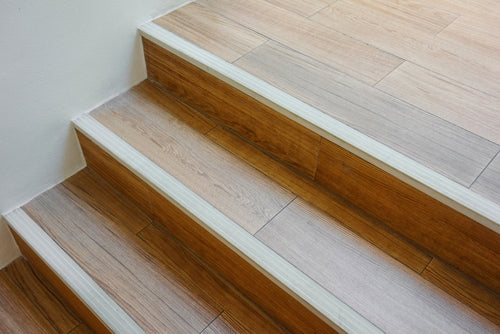
What are Stairnosings?: The Types and Uses
The key to a functional and well-designed staircase is the addition of stairnosings. If you’re redesigning your stairs, you will need to understand the different types and their purposes.
At Mersey Flooring, we will talk you through what stairnosings are, the different types and their importance, and how to install these in your home.
Our stairnosings are designed with quality and style in mind, perfect for various types of stairs and home interiors.
What are Stairnosings?
Stairnosings are designed to cover the protruding edge of the stair. These are the horizontal, slightly overhanging parts at the end of each stair tread.
They often feature a non-slip surface and have a contrasting colour to the stairs to make them more visible. Stairnosings can be flat, round, or angled, depending on personal preference.
The Importance of Stair Nosings
The primary purpose of stairnosings is to prevent slipping, enhancing the safety of your staircase.
This makes it easier to maintain footing, especially in high-traffic areas or during adverse weather conditions for outdoor steps. As the nosings protect the edge of the stairs, this increases the lifespan of the structure as this faces the most wear and tear.
In the UK, specific building codes and safety standards mandate the use of stairnosings, particularly in public and commercial buildings.
The Types of Stair Nosings
There are various types of stair nosings available. This creates plenty of options for modern, traditional, and contemporary interiors.
This includes:
Material
- Metal nosings: Made from aluminium, stainless steel, or brass. These are ideal for high-traffic areas as they can withstand heavy usage.
- Wooden nosings: This is a classic and elegant style, making them a popular choice for residential homes.
- Rubber and PVC nosings: Rubber nosings are known for their non-slip properties and their effectiveness in absorbing impact, making them a comfortable and safe option.
Design
- Flat profile: Often used in modern or minimalist designs.
- Bullnose profile: Suitable for contemporary and classic stair designs.
- Angled profile: These offer more surface area for walking, ideal for industrial or commercial settings for added safety.
Tools and Materials Needed
Stairnosings are quite straightforward to install. All you will need is:
- Your chosen stairnosings
- Adhesive or fasteners
- Measuring tape
- Pry bar and utility knife
- Screws, nails or clamps
- Level and pencil
- PPE: gloves and safety goggles
How to Install and Maintain Stairnosings
- Clean the staircase: Clean the staircase thoroughly, vacuuming any debris and wiping down the surfaces.
- Remove old stairnosings: Carefully remove any old stairnosings with a pry bar and utility knife if necessary
- Measure your stairs: Measure the length of your stair treads with measuring tape. Then, cut your new stairnosings to the length of the treads.
- Apply the adhesive: Apply a good amount of adhesive to the back of each stairnosing or directly on the stair tread.
- Position the stairnosing: Carefully align your stairnosing with the edge of the stair tread, ensuring it's straight.
- Secure the stairnosing: Secure the nosing in place with screws, nails, or clamps for a secure fit. Apply pressure on the stairnosing to allow the adhesive to stick effectively.
Choose Mersey Flooring for Your Stairnosing
At Mersey Flooring, we specialise in high-quality flooring for commercial and residential settings in the UK.
With a range of durable flooring options available, including Vinyl, Laminate, and waterproof flooring, we have an option for every interior.
We also supply flooring accessories including our stairnosings, as well as a range of underlay and skirting boards for a secure floor. Browse our products today or contact our team of experts for more information.